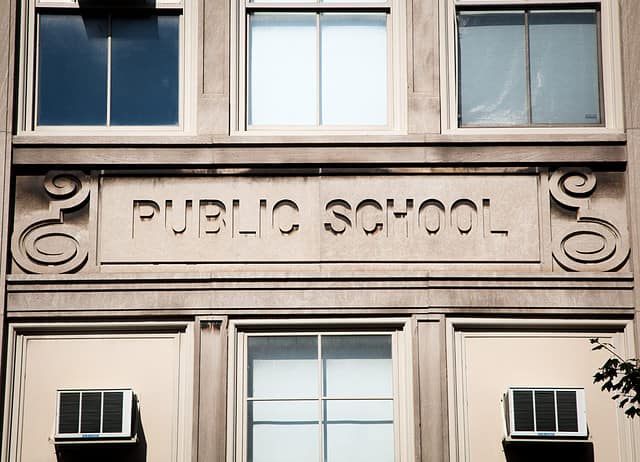Texas boasts a myriad of affluent public schools, but which one stands above the rest in terms of prosperity? Delving into the realm of education, this article examines the landscape of wealth in Texas’ public school system, shedding light on the crowned jewel of educational prosperity. As we delve into the figures and facts surrounding public school funding, prepare to discover which institution claims the coveted title of the richest public school in Texas.

This image is property of www.momswhothink.com.
Background
Overview of public schools in Texas
Public schools in Texas play a critical role in providing education to a diverse student population. With over 1,200 school districts, Texas has one of the largest public school systems in the United States. These schools cater to students from a variety of socio-economic backgrounds, creating a vibrant and dynamic educational environment.
Importance of funding for public schools
Funding is crucial for public schools to provide quality education, maintain infrastructure, and support various programs and activities. Adequate funding ensures that schools can offer a wide range of resources and opportunities to their students, ultimately contributing to their academic success and personal development.
Definition of ‘richest’ public school
When referring to the ‘richest’ public school in Texas, it typically relates to the school with the highest financial resources and funding. This article will explore the factors that contribute to a school’s wealth and highlight some of the wealthiest public schools in Texas.
Factors Affecting Wealth
Local property taxes
A significant factor influencing a public school’s wealth is the local property tax base. Local property taxes make up a substantial portion of school funding in Texas. School districts located in affluent communities with higher property values tend to have a larger tax base, resulting in increased funding for their schools. This provides them with additional resources to invest in programs and educational opportunities for their students.
State funding
Apart from local property taxes, the State of Texas plays a significant role in funding public schools. The state’s funding formula, known as the Foundation School Program (FSP), distributes funds to districts based on various factors such as student enrollment, district size, and local property values. While state funding aims to address disparities between wealthier and lower-income districts, it may not always fully equalize resources.
Donations and endowments
Wealthy public schools in Texas may benefit from additional funding through donations and endowments. Philanthropic individuals, alumni, and community members often contribute financially to these schools, providing resources beyond what is typically provided through property taxes and state funding. Donations and endowments can support scholarships, extracurricular activities, infrastructure improvements, and promote innovation within the school.
Wealthiest Public Schools in Texas
School A: Funding details and sources
School A, located in an affluent neighborhood, benefits from significant local property taxes due to high property values. This substantial tax base provides the school with a significant portion of its funding. Additionally, the school has actively sought and received generous donations from alumni and local businesses, further increasing their financial resources. These funds have been utilized for expansion projects, state-of-the-art facilities, and innovative educational programs.
School B: Funding details and sources
Situated in a well-to-do community, School B also benefits from a high local property tax base. The school district has made efforts to secure additional state funding through advocating for policies that prioritize educational equity. This combined with active fundraising efforts has allowed them to invest in advanced technology, professional development for teachers, and a wide range of extracurricular opportunities for their students.
School C: Funding details and sources
School C, located in a privileged district, has a favorable tax base that enables them to allocate substantially more funds towards their educational programs. The district has strategically pursued partnerships with local businesses, leveraging their resources to support innovative teaching methods, student scholarships, and community engagement initiatives. These partnerships have provided School C with additional financial support, empowering them to offer comprehensive educational experiences.
Comparing wealth and resources
When comparing the wealth and resources of these public schools, it is evident that schools located in affluent areas tend to have more financial resources at their disposal. However, it is important to note that wealth does not necessarily guarantee academic success. Factors such as effective resource allocation, teacher quality, and student engagement also play vital roles in determining a school’s overall performance.
Academic Performance vs. Funding
The correlation between funding and academic success
While funding is undoubtedly important for public schools, the correlation between funding and academic success is complex. While adequate funding allows schools to provide necessary resources, it is not the sole determinant of academic performance. Factors such as dedicated and skilled teachers, supportive learning environments, and parental involvement also significantly influence student achievement.
Case studies of high-performing wealthy public schools
Several high-performing public schools in Texas have demonstrated academic excellence despite not being among the wealthiest schools. These schools prioritize effective teaching methods, employ qualified educators, and actively engage students in their learning process. These examples showcase that while funding is important, effective utilization of resources and a focus on educational best practices can lead to exceptional educational outcomes.
Challenges faced by schools with fewer resources
Schools with limited financial resources face numerous challenges. They may struggle to provide essential resources such as textbooks, technology, and extracurricular opportunities, hindering student engagement and academic performance. Additionally, these schools often face difficulty attracting and retaining highly qualified teachers due to lower salary scales. These factors can perpetuate educational disparities and limit opportunities for students.
Efficiency of resource allocation
Efficient resource allocation is critical for ensuring that funds are utilized effectively to benefit students and enhance academic outcomes. Schools with limited resources must prioritize spending on areas that directly impact student learning. This can involve investing in teacher professional development, targeted intervention programs, and leveraging community partnerships to acquire additional resources. Implementing transparent and accountable resource allocation practices is vital to maximize the impact of limited funding.

This image is property of img.buzzfeed.com.
Impact of Inequality
Inequitable distribution of resources
One of the major concerns in Texas is the unequal distribution of resources among public schools. Disparities in local property tax bases, coupled with variations in state funding and private donations, contribute to educational inequalities. Lower-income districts often struggle to provide the same level of resources and opportunities as wealthier districts, leading to an uneven playing field for students.
Effects on student outcomes
The impact of resource inequality on student outcomes is significant. Students from lower-income districts may have limited access to quality education, advanced courses, and extracurricular activities. This can result in lower graduation rates, decreased college readiness, and reduced opportunities for future success. Educational disparities perpetuated by wealth inequality can contribute to the cycle of poverty and hinder social mobility.
Initiatives to address educational disparities
Recognizing the importance of educational equity, various initiatives have been implemented to address disparities among public schools in Texas. These initiatives include targeted funding programs, school improvement grants, and regional collaborations to share resources and knowledge. Efforts are also being made to provide additional support and resources to schools serving economically disadvantaged students, ensuring that they have access to quality education.
Policy recommendations
To further address educational disparities, policy recommendations should focus on increasing state funding for struggling districts, improving the fairness and equity of the funding formula, and encouraging philanthropic organizations to direct resources to underprivileged schools. Additionally, promoting collaboration between schools and districts can help share best practices and resources, fostering a more equitable and supportive educational environment.
Community Contributions
Role of community involvement
Community involvement is crucial for enhancing public schools’ resources and overall effectiveness. Engaged community members can provide valuable support, whether through volunteering, mentoring, or fundraising efforts. Their involvement fosters a sense of ownership and collective responsibility, creating a more inclusive and supportive educational community.
Volunteer programs
Volunteer programs play an essential role in supplementing school resources. Individuals from the community can contribute their expertise and time to support students and educators. Programs such as tutoring, career guidance, and mentoring not only enhance student learning but also create connections between schools and the wider community, promoting a collaborative and supportive environment.
Partnerships with local businesses
Establishing partnerships with local businesses can provide much-needed resources and opportunities for public schools. Local businesses can contribute financially, sponsor educational programs, or offer internships and apprenticeships for students. These partnerships not only provide additional funding but also expose students to real-world experiences and career pathways, enhancing their educational journey.
Fundraising efforts
Fundraising efforts are another way communities can support public schools. These efforts can take various forms, such as charity events, grants, and sponsorships. Fundraising campaigns can help bridge funding gaps for schools, allowing them to invest in essential resources and programs. Engaging the wider community in these efforts fosters a sense of pride and collective responsibility for the success of public schools.

This image is property of townsquare.media.
Examples of Successful Public Schools
Detailed profiles of top-ranked public schools
Several top-ranked public schools in Texas serve as exemplary models of academic excellence. These schools prioritize student achievement by focusing on rigorous academic programs, attracting and retaining highly qualified teachers, and promoting a positive school culture. They leverage their available resources to create a supportive and engaging learning environment for students.
Application of funds
Successful public schools allocate their funds strategically, ensuring that resources are utilized effectively to support student success. They invest in professional development opportunities for teachers, offer a variety of enrichment programs, and provide well-rounded educational experiences. These schools prioritize student engagement, critical thinking, and personalized learning, ensuring that students are equipped with the necessary skills for future success.
Academic achievements
Top-ranked public schools consistently achieve high academic outcomes, reflected in standardized test scores, college admission rates, and academic accolades received by their students. They foster a culture of high expectations, collaborative learning, and rigorous coursework. These schools prepare their students for a competitive global landscape, equipping them with the knowledge and skills needed to excel academically.
Extracurricular opportunities
Successful public schools recognize the importance of extracurricular activities in holistic student development. They offer a wide range of extracurricular opportunities in areas such as sports, arts, leadership, and community service. These activities enhance students’ social and emotional skills, promote teamwork, and nurture their individual talents and interests.
Controversies and Criticisms
Unequal opportunities for low-income students
One of the primary controversies surrounding public schools in Texas is the unequal opportunities provided to low-income students. Disparities in funding and resources contribute to inequitable access to quality education, resulting in unequal academic outcomes. Efforts to address these inequalities should be prioritized to create a level playing field for all students.
Perceptions of elitism
Wealthier public schools sometimes face criticism for perpetuating elitism. The perception that these schools cater primarily to privileged students can hinder efforts to promote diversity and inclusion. It is crucial for these schools to actively address these perceptions by fostering a welcoming and inclusive environment and implementing initiatives to increase access for all students.
Impact on neighboring school districts
The concentration of wealth and resources in certain public schools can have a significant impact on neighboring districts. School districts with fewer resources may struggle to attract highly qualified teachers, retain students, and offer competitive academic programs. Addressing these challenges requires a comprehensive approach that ensures all students have access to a high-quality education.
Calls for educational reform
The disparities in funding and resources among public schools in Texas have sparked calls for educational reform. Advocacy groups, policymakers, and community members are pushing for changes in the funding formula, increased state funding for economically disadvantaged districts, and a more comprehensive effort to address educational inequities. The push for reform aims to provide equal educational opportunities for all students, regardless of their background or ZIP code.

This image is property of www.momswhothink.com.
Future Outlook
Potential funding changes
The future of funding for public schools in Texas is likely to witness changes as policymakers recognize the need for increased investment in education. Potential funding changes could include revising the funding formula to provide more equity, exploring alternative revenue streams, and identifying innovative ways to allocate resources effectively. These changes aim to ensure that schools have the necessary funding to meet the evolving needs of students.
Addressing educational disparities
Addressing educational disparities will remain a key priority in the future. Efforts to close the achievement gap and provide equal opportunities for all students will require collaboration between policymakers, educators, and the broader community. A comprehensive approach that focuses on both funding improvements and educational reforms will be necessary to create a more equitable and successful public school system.
The role of government in equalizing resources
Government intervention plays a crucial role in equalizing resources among public schools. Policymakers must continue to review and refine the funding formula, ensuring that it adequately addresses disparities and promotes equal access to quality education. Robust oversight and accountability mechanisms are also necessary to ensure that funding is allocated efficiently and transparently.
Conclusion
The wealth and resources of public schools in Texas play a significant role in shaping the quality of education offered to students. While funding is crucial for ensuring adequate resources and opportunities, it is not the sole determinant of academic success. The challenge lies in addressing disparities, promoting effective resource allocation, and fostering an inclusive and equitable educational environment. By working collaboratively, policymakers, educators, and communities can strive towards creating a public school system that provides equal opportunities for all students, regardless of their economic background.

This image is property of s.hdnux.com.
